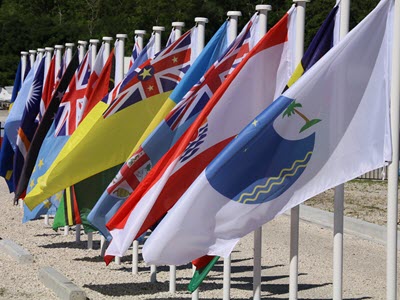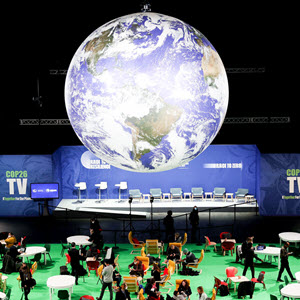Roundtable from Beyond COP26: Regional Cooperation for Climate
A Pacific Island Perspective on COP26
This essay by Alisi Rabukawaqa-Nacewa is part of the roundtable Beyond COP26: Regional Cooperation on Climate Change.
At COP26 in November 2021, global leaders debated the best measures to “stabilize greenhouse gas concentrations in the atmosphere at a level that will prevent dangerous human interference with the climate system, in a time frame which allows ecosystems to adapt naturally and enables sustainable development.” These discussions examined the difference between limiting global temperatures to a 1.5°C increase versus a 2°C increase and considered what climate pledges and strategies could make that more ambitious goal possible. Given that the impacts of a 1.5°C increase are significantly lower, countries urgently need to reduce emissions by 45% by 2030 from 2010 levels. To meet this accelerated timetable, the Glasgow Climate Pact called on parties to “revisit and strengthen” their climate pledges by the end of 2022.
For Pacific Island countries, this decision to revisit pledges made under the 2015 Paris Agreement of COP21 to reduce emissions and limit warming to 1.5°C was a significant development. Going into COP26, the Pacific Island countries were clear on their position on several key issues. In particular, Pacific leaders called for “new commitments to stronger 2030 NDC targets, and carbon neutrality by 2050.”
Pacific youth have played an important role in this process. They came together in the midst of the Covid-19 pandemic for a hybrid two-day Youth4Pacific event, gathering over 630 registrants from 33 countries for a knowledge-sharing conference targeted at building ambition, community, skills, and power for the Pacific region. Youth participants were able to articulate their concerns and leverage best practices to apply pressure on world leaders through a Youth4Pacific declaration.[1] The declaration was received by the British high commissioner to Fiji (leveraging the UK presidency of COP 26) and called on global leaders from developed countries with the highest carbon emissions to curb their emissions by at least 50% by 2030 to bring about a just transition from fossil fuels to renewable energy.
These are not by any means flippant demands but represent the collective voice of those on the front lines of climate change who do not experience the devastation of anthropogenic climate change in the abstract through reports or studies but as part of their everyday lives. This commentary will focus on two issues of particular concern for Pacific Island countries: protecting oceans and insuring against loss and damage from climate change.
PROTECTING OCEANS
Ocean health, climate change, and biodiversity have traditionally been siloed in UN processes. The strong push from the global oceans community to incorporate ocean health into the UN climate change regime led to this issue finally being mentioned in the Glasgow Pact. This is a tangible step in not only recognizing that ocean health is inextricable from the issues of climate change and biodiversity but ensuring that mechanisms are developed and appropriate financial contributions are made to protect oceans and the populations that depend on marine ecosystems for their livelihood.
However, while the world is still planning in decades, the world’s oceans reached record temperatures in 2021. Warming oceans, combined with melting glaciers, mean rising global sea levels, which have a multitude of ecological impacts. Warming oceans threaten marine ecosystems and in turn human livelihoods. For example, warm waters jeopardize the health not only of corals but of the communities of marine life that depend on them for shelter and food. People who depend on fisheries for their livelihood or live in low-lying coastal communities, as many do in the Pacific, face the negative impacts from warming oceans first and hardest.
Warmer waters also provide more energy for tropical storms, increasing their intensity and longevity. For example, Fiji has experienced ten tropical cyclones since 2016, two of which were category 5. Tropical Cyclone Winston made landfall in February 2016 and killed 44 people. The estimated value of losses from the cyclone was around F$2 billion[2] (US$0.9 billion), including F$1.29 billion (US$0.6 billion) in destroyed physical assets and F$0.71 billion (US$0.3 billion) in other losses.[3] In December 2020, Fiji was hit by another category 5 storm, Cyclone Yasa, which caused estimated losses of almost F$500 million, according to the Fiji government.[4]
INSURING AGAINST LOSS AND DAMAGE
The heightened threat of tropical storms caused by warming oceans raises the subject of loss and damage. Within the UN Framework Convention on Climate Change, loss and damage refers to the harm caused by anthropogenic climate change, where climate impacts exceed the adaptive capacity of countries, communities, and ecosystems. Measures to secure dedicated financing to insure against loss and damage were watered down by developed countries in the final days of COP26, to the great disappointment of Pacific Island countries. Although the conference ended with no clear assurance of how this would lead to clear deliverables or outcomes for loss and damage financing, the parties agreed to resume talks on governance of the Warsaw International Mechanism for Loss and Damage at COP27.
What becomes of Pacific Island countries that sustain millions and even billions of dollars of damage without enough time to recover? Communities like Cogea Village in Bua Province, on the second-largest island of Fiji, were completely battered by three severe cyclones in the span of ten months. As a result, a small, close-knit community of 37 households had no choice but to leave their ancestral lands and rebuild their lives elsewhere. Another decade of climate talks will not help such communities develop their adaptive capacities.
POLICY OPTIONS
With their nations facing existential peril, Pacific Island leaders are demanding concrete action as the international community looks toward COP27. The following steps would help ensure that global climate efforts move beyond words and discussion into concrete actions.
First, the pledges made at COP26 should not be viewed as indicators of success in addressing climate change. Instead, the phaseout of fossil fuels and a just transition to renewable energy sources should be the main markers of success.
Second, countries and corporations should not only commit to reducing fossil fuels. They should also work to ensure that those whose lives depend on the fossil fuel industry are upskilled to participate in the renewable energy economy.
Third, COP27 should feature updated, recommitted climate pledges from participant countries. These should be based on what the latest science is telling us, rather than simply making a pact to revisit climate pledges.
Fourth, on the critical topic of loss and damage, countries should not wait another year to resume talks. Rather, they should identify new finance sources and ensure that these are distributed as grants, not loans, to effectively help countries that are most vulnerable to loss and damage from climate change.
Parties to the Climate Convention are not yet on track to meet the objectives of the Paris Agreement. Yet, despite the lack of progress in some areas, the COP26 outcomes do provide a basis for translating commitments into concrete actions. To do so, global leaders must be reminded that the conference is not the work; the work happens after the conference ends.
Alisi Rabukawaqa-Nacewa has spent the past decade working on environment conservation, climate activism, and indigenous peoples’ traditional rights and knowledge advocacy. She sits on the youth-led grassroots network 350.org Pacific Climate Warriors Council of Elders as the Melanesian representative and volunteers as the coordinator for a network of young professionals from her province in Bua, Fiji, called the Bua Urban Youth Network. She also works as a marine scientist with the International Union for the Conservation of Nature, providing consultation on marine protected areas within Fiji and with communities.
Endnotes
[1] The full declaration is available at https://www.youth4pacific.org/declaration.
[2] Simone Esla, “Fiji Post-Disaster Needs Assessment: Tropical Cyclone Winston, February 20, 2016,” May 2016, Government of Fiji, 10, https://www.gfdrr.org/sites/default/files/publication/Post%20Disaster%20Needs%20Assessments%20CYCLONE%20WINSTON%20Fiji%202016%20%28Online%20Version%29.pdf.
[3] These figures exclude the environment sector because environmental assets and flows of environmental services are not included in the national accounts.
[4] Fonua Talei, “Cyclone Yasa Damage Costs Hit $500m: Seruiratu,” Fiji Sun, February 13, 2021, https://fijisun.com.fj/2021/02/13/cyclone-yasa-damage-costs-hit-500m-seruiratu.



